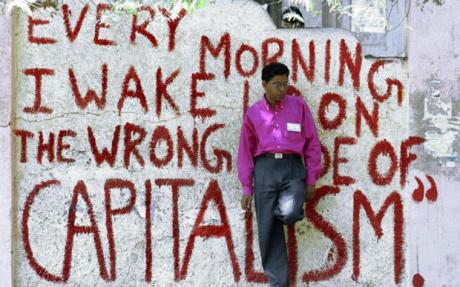The latest Expert Advisory Group on Poverty (EAG) update “Child Poverty in New Zealand: Building on the progress to date” 29th October 2013 notes there has been modest progress on only some issues for children, and none on incomes.
“The Government has not undertaken any of the EAG’s recommended steps to address the income adequacy for children living in poverty.”p8
Nothing? Diddly squat. Zilch. Large fat salaries continue to rise but as Olivier Twist found in the 19th century there is just no more for needy children.
The first EAG report “Solutions to child poverty” released nearly a year ago had been clear that it is imperative to increase income support for children, suggesting policies of around an extra $1.5-2 billion a year would be needed. The Expert Group must be very, very disappointed with the subsequent nil response and dismissive attitude from government. There is not even a proper inflation adjustment in sight. It must be especially galling after all their work since it now it looks like another budget and another year will slip by and a change of government will be needed to get any action at all .
The EAG say that there should be increases to the Family Tax Credit. This is part of Working for Families paid weekly to the caregiver for all low income children. Currently the first child payment of the Family Tax Credit is $92 a week unless the child is over 16 (when it is $102). A second child gets $64 if aged under 13, if 13-15 the rate is $73 and $91 if over 16. (IRD website).
The EAG say
| “If we applied the investment approach to the Family Tax Credit (FTC), we could target more support where it matters most and where child poverty is higher – for younger children and larger families. We recommend eliminating the different rates and having one single per-child rate (preferably based on the rate for 16 years or older). This would provide more money for younger children and reduce child poverty rates for those who benefit most.”P2
|
Actually the Ministry of Social welfare data shows that 55% of poor children are in 1 or 2 child families. For those with one child the EAG recommendation would mean just another $10 a week ($92 to $102), a quite insufficient amount to lift that family out of poverty. Thus the poorest one-child family would not be helped materially, and a two child family would get only another total $47 per week.
Leaving that aside, the real problem is that the EAG offered a solution that is too easy for the government to dismiss as unaffordable. Many larger families on incomes of $120,000 or over would gain, many of them substantially. Currently a five child family does not have all the Working for Families abated away until $144,000- if the EAG’s proposals increase the FTC by $10 for the first and $40 per week per additional child, then a 5 child family on $144,000 would get an extra payment of $8870 a year, and that would not be fully abated until $186,000. All the while, the really poor one- child family gets only another $10 a week?
The cost of pushing WFF up the income scale would be very high but even so, not very effective for the majority of poor children. The EAG recommendation is unlikely to be politically acceptable on fiscal grounds. Nor should it be.
Why was the In work tax credit bit of Working for Families off limits to their scrunity? The In Work Tax Credit abates only after the Family Tax Credit has gone and so goes to lots of high income families way up the income scale. If the EAG’s argument is that ‘working’ families, including many on $120,000+ need the In Work Tax Credit to meet the extra costs of being in work (even though the caregiver may not be in paid work) then the rationale rings very hollow indeed. There should have been an open rigorous and politically independent process of scrutiny of the In Work Tax Credit. Why did the “independent” EAG not to provide this?
As CPAG has argued the first, most cost effective step to tackle child poverty in a real, and meaningful way, with zero leakage up the income scale is to transfer the misnamed In Work Tax Credit of $60 a week into the Family Tax Credit. If the $60 IWTC was added to the first child Family Tax Credit and the 4th and subsequent children given a $15 increment in their Family Tax Credit, all children would be treated the same for Working for Families and child poverty would begin to fall in an meaningful way. At a cost of $450m, this is a fraction of what the EAG would spend, but in terms of child poverty it would achieve far more. Moreover it might reflect a courageous statement of values that all low income children should be treated the same as far as social security tax- funded spending to alleviate poverty goes. Is this too much to hope for?






“As CPAG has argued the first, most cost effective step to tackle child poverty in a real, and meaningful way, with zero leakage up the income scale is to transfer the misnamed In Work Tax Credit of $60 a week into the Family Tax Credit.”
It would only be misnamed if paid to beneficiary families.
It was a Labour Party policy designed to make work more financially rewarding. It was Clark and Cullen who believed paid work was the best way to reduce child poverty – not the benefit system.
And would be viable if the government was working to a full employment plan rather than the neo-liberalism of the last 30 years.
UBI would do away with the need for any complexity in the welfare state.
…and the rising prices are forever ahead of the teeny-tiny increases.
Power. Housing costs. Fuel and transport. Food. Schooling costs.
It’s all spent before it ever arrives. It all gushes out to people who ‘know they’re worth it’ and firmly believe that their ‘excellences’ are worth the juicy pay packets – with very little foundation for their hubris. The proverbial ‘rainy day’ turns into one long, unending Typhoon Haiyan. Thrift and prudence are punished repeatedly, particularly by stupid welfare systems.
If you want to increase the number of people out of poverty – and making upward progress, then you’ll also have to deal with the cloud of vultures circling for their cuts and crumbs. And the rules that stop aspiration before the first breath gets taken.
We need to revive the demand for full employment and a return to public ownership in major industries – the solution to the root cause of the problem. Obviously smaller gains like tax credits need to be won in the meantime, but it’s easy to get caught up squabbling over the crumbs and miss the big picture.
I would hope that a full employment campaign might also challenge this constant bashing of the unemployed. People need to realise that in today’s perpetual-slump economy, they too could be in the dole queue tomorrow.
Can WfF and implement a universal child payment of $6000 per year per child paid to all families. ZOMG, the rich will get benefits? Easy, increase taxes on the rich.
“Let’s have…..”
A complete overhaul of “government’.
Business Roundtable shall have NO input in social policies.
No persons of ‘economic/business background shall have any say in social policy, (with the exception of those who have long term experience in the “helping professions” ie those who have genuine empathy with people , and an understanding of their problems, along with solutions.)
All social policy shall be examined for potential negative repercussions in the long term, before being implemented.
etc etc
So long as no left wing organisation has a say in economic policy then.
[…] Let’s have less handwringing and more realism on incomes policy. By Susan St John https://thedailyblog.co.nz/2013/11/16/lets-have-less-handwringing-and-more-realism-on-incomes-policy/ […]
Comments are closed.